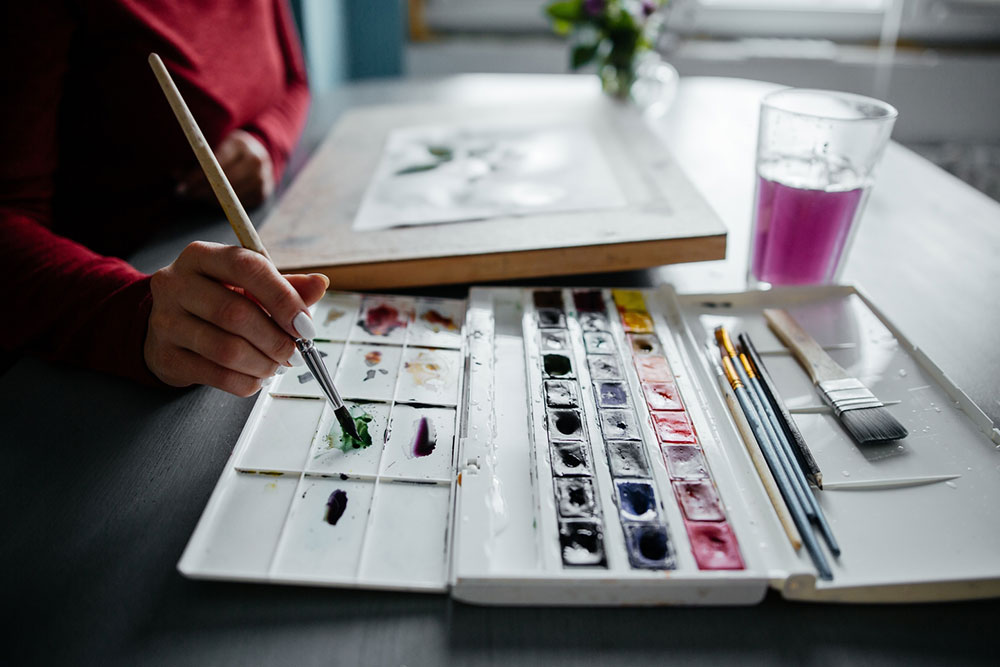A Beginners Guide to Watercolor Painting
Watercolor painting is a captivating art form admired by many. It involves painting a picture using watercolors or color pigments mixed with water. See below the key steps in painting with watercolors, some artistic ideas, and essential tips and techniques.
Key steps involved in watercolor painting
Here are a few steps that go into painting a picture with watercolors:
- Gather the materials
To get started, one needs watercolor paints, brushes, watercolor paper, a palette, clean water, and a well-lit and comfortable workspace. - Sketch an idea
Lightly sketch a chosen subject onto the paper using a pencil. Don’t press too hard, as it could lead to visible lines.

On a palette, mix the colors needed for the painting. It’s helpful to have a range of shades ready before beginning.
Begin with a light wash of color to establish the overall tone of the painting. Let it dry before adding layers.
Gradually add more layers, allowing each to dry before applying the next. Layers build depth and intensity in the painting.
Use finer brushes and dry brushing techniques to add intricate details and highlights.
Step back and evaluate the painting. Make any final adjustments or enhancements as needed.
Once the painting is complete and dry, consider using a fixative or framing it under glass to preserve it.
Must-try watercolor painting techniques
The following are a few widely-used techniques to enhance watercolor paintings:
- Wet-on-wet
Wetting the paper with clean water before painting facilitates soft, blended edges, perfect for creating dreamy backgrounds. - Dry brushing
Use less water on the brush for a dry-brush effect. This technique is ideal for adding texture and fine details. - Layering
Apply multiple layers of watercolor to intensify shades and create depth. Start with light washes and gradually build up the tones. - Salt texture
While the paint is still wet, sprinkle table salt over the paper. As it dries, the salt will absorb some of the paint, creating unique textures and granulated patterns. - Splatter
It involves splattering paint onto the paper to create exciting textures. - Masking fluid
One can use masking fluid to preserve areas of the paper they want to keep white. After painting, simply rub off the masking fluid to reveal pristine paper underneath. - Collage technique
Combine watercolors with collage elements like newspaper clippings or torn paper to add depth and texture to the artwork. - Negative painting
This is a technique where one paints the space around an object, allowing the subject to emerge naturally. It’s a great way to create intricate details and depth.
Ideas to get started
Those looking for ideas for their painting can check out the following suggestions:
- Nature’s symphony
Nature has always been an inspiration for artists. Consider painting landscapes, seascapes, or botanicals. Capture the serenity of a forest, the power of crashing waves, or the delicacy of blooming flowers. - Portraits and people
Watercolors can beautifully depict the human form. Experiment with portraiture or candid scenes that capture the essence of everyday life. - Abstract expressions and personal symbolism
Unleash creativity by exploring the abstract watercolor technique. It involves using watercolors to express one’s personal journey or emotions through symbolic imagery and abstract shapes. One can let their emotions guide their brushstrokes and see where their instincts take them. - Still life
Arrange objects in a visually appealing composition and paint them with watercolors. Common subjects include fruits, flowers, or everyday objects that tell a story. Pay attention to lighting and shadows for a realistic effect. - Animals and wildlife
Individuals can create captivating wildlife scenes or celebrate their favorite pets through watercolors. The gentle flow of colors can capture the grace and spirit of animals. - Cityscapes
Create vibrant urban scenes featuring skyscrapers, bustling streets, and iconic landmarks. - Underwater worlds
Explore the depths of the ocean and paint colorful coral reefs, exotic fish, and marine life. Watercolors are perfect for conveying the fluidity of water.
Remember, the beauty of watercolors lies in their versatility. Don’t be afraid to experiment, mix colors, and try new techniques to bring ideas to life on paper.
Which color to use?
Understanding the psychology of colors is essential when deciding on a shade. Different hues can evoke different emotions and set the mood for one’s artwork:
- Blue emanates calmness, serenity, and stability, perfect for tranquil seascapes and peaceful landscapes.
- Red can add vibrancy to one’s paintings or evoke strong emotions like passion, energy, and love in portraits.
- Yellow emanates joy, optimism, and warmth, excellent for sunny scenes and cheerful compositions.
- Green is ideal for botanical illustrations and scenes of nature. It depicts harmony, growth, and renewal.
- Purple can bring a sense of magic to one’s artwork by instilling a sense of spirituality or mystery.
- Orange emanates enthusiasm, vitality, and balance. It works well for energetic and dynamic subjects.
Remember, practice is critical to mastering watercolor painting. Don’t be discouraged by initial challenges; embrace them as opportunities to learn and grow as an artist. Dedication and experimentation can help churn out masterpieces. Happy painting!
